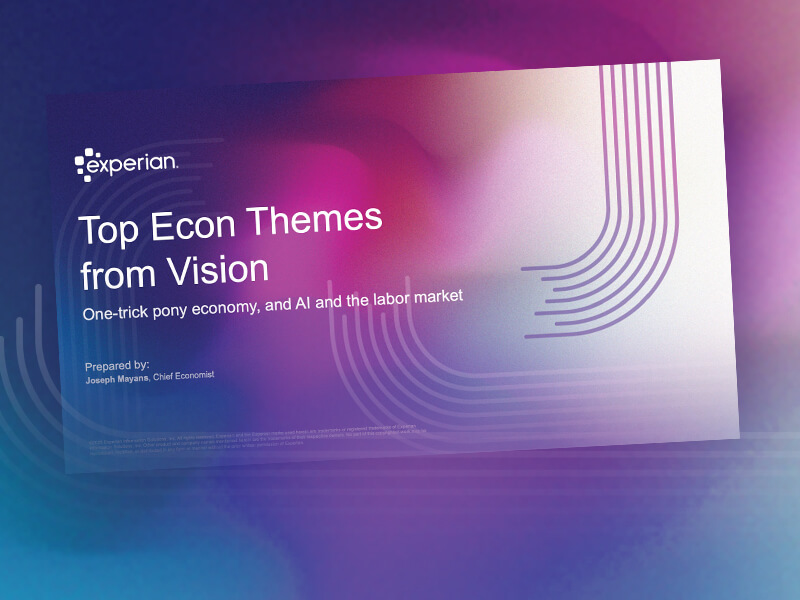Report
Published May 31, 2022
Commercial Commercial Insights Credit & Economic TrendsExperian begins a new chapter with the release of the Q1 2022 Main Street Report through our collaboration with the leading economists at Oxford Economics. During Q1, small businesses kept average commercial loan balances healthy and stable. At the same time, moderate delinquency inched up but remained low overall as business and consumer travel returned to form, offering major tourist destinations a boost.
Complete the form to access the report
This site is protected by reCAPTCHA and the Google Privacy Policy and Terms of Service apply.
Thank you for your interest
Your free Experian resource is now available. Enjoy!
 Webinar
Webinar
Macroeconomic forecasting and credit trends - November 2025
As we step closer to 2026, all eyes remain on the economic outlook, the labor market and consumer health. Experian’s Chief Economist Joseph Mayans, Director of Fintech Gavin Harding and Solution Insights Director Amanda Roth, will provide a look into:
- The latest economic and credit trends
- Labor market and consumer health
- Student loan update
 Video
Video
Rising Delinquencies Signal Growing Risk in Transportation & Warehousing
As the U.S. economy continues to recalibrate post-pandemic, the transportation and warehousing segments of the logistics sector are signaling caution. While the broader logistics industry has remained in expansion mode, Experian’s latest Commercial Pulse Report reveals that delinquencies are rising—an early warning of growing risk in two of the economy’s most critical subsectors.
Check out the full report to see how these trends could impact your strategy!
 Report
Report
Top Econ Themes from Vision
The U.S. economy continues to surprise with its resilience - growth forecasts are improving, equity markets are hitting new highs, and fears of an imminent recession are fading. Joseph Mayans’ Vision 2025 session, “Navigating 2026: Global Macro Shifts, U.S. Credit Trends and the Evolving Lending Landscape,” explored the economic forces shaping the next year - from the AI-driven equity boom to structural vulnerabilities in the white-collar labor market. His key takeaway: while AI innovation is fueling growth and optimism, it also introduces new dependencies and risks that will define the next economic chapter.
Highlights:
- The AI Trade’s Dominance: Economic optimism is increasingly tied to the AI investment cycle—AI spending fuels stock gains, which in turn sustain higher-income consumer spending.
- Potential Vulnerability: Overreliance on AI-driven growth leaves the economy exposed if those massive investments fail to deliver expected productivity gains.
- Labor Market Shifts: AI is intensifying existing white-collar labor market imbalances—more graduates, fewer roles, and increasing automation pressure.
- Credit Market Implications: Rising white-collar vulnerability poses a growing risk for prime credit segments, especially if economic momentum slows.
- Future Readiness: As Sol Rashidi emphasized, humans’ edge lies in creativity and critical thinking—skills that should be strengthened, not outsourced, to AI.
 White Paper
White Paper
State of Student Loans
Explore Experian’s latest State of Student Loans white paper to uncover key trends, borrower insights, and the evolving impact of student debt on financial health. Learn how data-driven solutions can help lenders and consumers navigate today’s student loan landscape.
Key considerations include:
- Strategies to engage consumers proactively to provide resources
- Recalibration of risk models
- Mitigating fraud while navigating the changing landscape